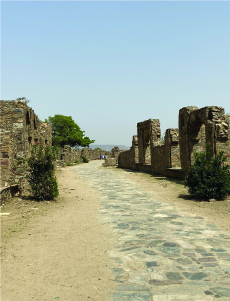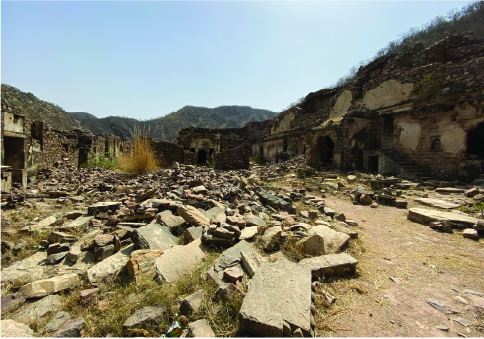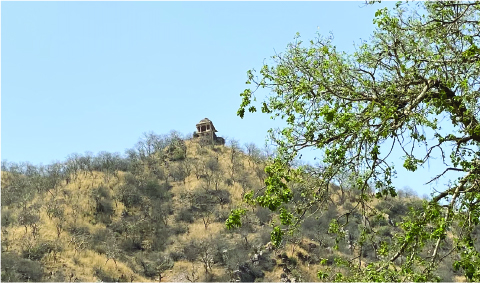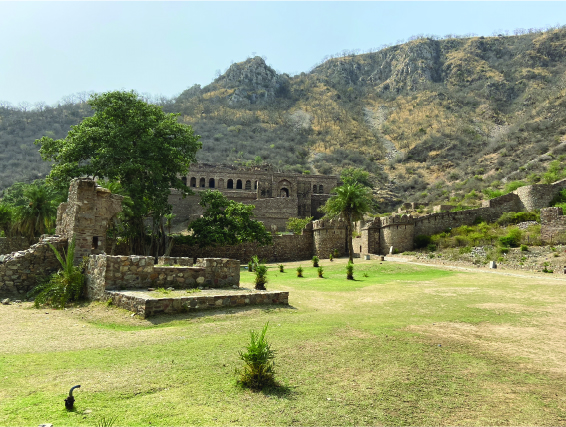Just 90 kms away from Jaipur (the nearest airport), the Bhangarh Fort beckons with its unique mystic! The drive to the fort is laced with captivating imagery as it passes through the Sariska Reserve and finally lands you in the lap of a valley but not before you have coughed up ₹50 per vehicle as toll.
There is enough parking for the visitors which is why tourists do not feel inhibited to visit. Tickets can be bought without hassles either on the counter or through an app for ₹25 or ₹20 respectively. Before the Archaeological Survey of India shouldered the supervision of the monument, there was no entry fee.
A part of the mystic has something to do with the timings of the visit – 10am to 6pm. It is generally believed that after 6pm the fort is besieged with paranormal activity but there is little to substantiate that beyond the legends that surround it. All those stories of mishaps inside the Fort in the night appear to be hearsay. Some locals say that in the past the fort with its ruins was a haven for anti-social elements from nearby hamlets as they would use it to drink, gamble and loot people on a visit. Since the Fort happens to lie within the Sariska precincts, it is also host to wild animals who quench their thirst from a nearby pond. The attacks by wild animals and the presence of notorious elements conjured up the image of the Fort as “haunted”.

Undoubtedly among the best forts we visited in the country, it has a potential tourism attraction. Apart from the structure, it has an interesting history that lends it a peculiar feel.
About the fort…
History has it that the Fort was built by one Bhagwant Das for his son Madho Singh. Of the five gates, four have been closed by the ASI and only one called Hanuman Pol – because of the Hanuman temple next to it – is functional. The other 4 gates are the Lahori Pol, the Ajmeri Pol, the Phulbari Pol, and the Delhi Pol. Once you pass by the Hanuman Pol, you enter the ruins of the market place called Johri Bazaar, believed to be a takeoff on the Bapu bazaar of Jaipur. The ruins suggest that this must have been a thriving market in its heyday.
Leaving behind the bazaar, we enter the main fort area comprising the temples and the havelis (large mansions). Amidst the ruins, the Shiva and Krishna temples, right at the foothills of the Fort, have managed to survive. Quietude prevails at the place as the temples are defunct but a well maintained garden right at the base of the Fort, corners your attention.

Like all forts, typically nestled on the hills, the entrance is a 200 meters slant that leads you to a palace in ruins. Once a 7-storey structure, it has crumbled to just 3-storeys. Made up mostly of black stone, there is a patch of white marble with some carvings. The view from the top is as majestic what with the vast expanse of the mountains that your eyes can soak in. The summit of the mountain range has a watch tower and fable has it that a tantrik residing there was responsible for the fort’s ruination.
As you descend the stairs, towards your left you come across an arched hallway that supposedly served as the prison. At the end of the hallway there is a small room with its stairs leading down into the dungeon. It remains unexplored till date with stories of negativity around it – the spooky side of the Fort.

Another spooky side is at a level down when you enter another arched hallway on the right. This hallway leads you to the end of the Fort where lies a small enclosure where the locals visit to worship a Djinn. It is said that the complete hallway is haunted by that Djinn. People continue to please him with offerings and whoever is possessed by the Djinn remains unmarried.
Haunted folklores…
There is a folklore that surrounds the Bhangarh. Surprisingly, even the ASI guide accompanying you avers that the destruction of the fort was caused by Tantra (supernatural power). Our guide chose to defend his contention saying “Saab, 500 saal pehle kisne jaake dekha he ki kya hua tha (who knows what happened 500 years back).
The story
It is said that after the death of the king of Bhangarh, Rani Ratnavati took over the reins. A Tantrik fell in love with Ratnavati and in order to win her he cast a spell on a potion and asked one of the shopkeepers in the Bazaar to sell it to the Rani’s maids. When the maid took the potion to the queen, she sensed a weird smell and threw a few droplets onto a stone. The spell was so strong that the stone got enchanted and flew all the way to the Tantrik’s cave and fell on it killing him. Before dying, the Tantrik cursed the entire kingdom to get destroyed by stones falling from the sky. That’s what is believed to have happened.

There are many such legends associated with the cursed and the mysterious Bhangarh Fort, but no one has been able to demystify the facts from the legends. What is sure is the Fort despite being in a dilapidated state, continues to provide a grand setting for the travellers and the film folks. Quite a few movies have been shot there. The iconic choodi bazaar from the sets of movie “Karan-Arjun” is the Johri Bazaar of Bhangarh fort.
Bhangarh was an exhilarating experience. Folklores, rumours and everything else apart, the Fort still holds people in thrall. It stands true to the dictum that “khandhar kehte hai imaarat kitni bulund thi” (the ruins tell you how magnificent and strong the construction once was.)


 [/column]
[/column]